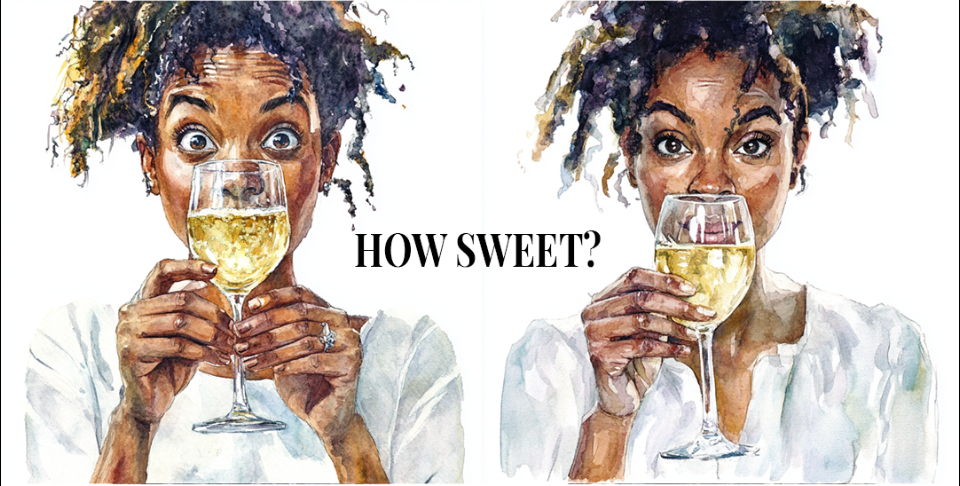The sweetness of wine is primarily determined by the amount of residual sugar (RS) left in the wine after fermentation. Residual sugar is the natural grape sugar that remains in the wine when fermentation is stopped before all the sugar is converted into alcohol by yeast.
Factors That Contribute to Wine Sweetness:
-
Residual Sugar (RS):
- The primary factor in determining a wine’s sweetness is the amount of residual sugar. During fermentation, yeast consumes sugar and converts it into alcohol. If the fermentation process is stopped early, before all the sugar is consumed, the remaining sugar adds sweetness to the wine.
-
Grape Varieties:
- Certain grape varieties naturally have higher sugar content. For example, Muscat grapes (used to make Moscato) and Riesling grapes tend to produce sweeter wines because of their higher initial sugar content.

-
Fermentation Process:
- The winemaker can control the sweetness by adjusting the fermentation process. Stopping fermentation early or using techniques like cold stabilization (chilling the wine to halt fermentation) can result in higher residual sugar, making the wine sweeter.
-
Fortification:
- Some sweet wines, like Port or Sherry, are made by adding distilled spirits (fortification) during fermentation. This process kills the yeast before it can consume all the sugar, leaving more residual sugar and resulting in a sweeter wine.
-
Climate and Harvest Time:
- Grapes harvested later in the season (late harvest) often have higher sugar levels, leading to sweeter wines. Warmer climates also produce riper grapes with more sugar, which can result in sweeter wines.
-
Chaptalization:
- In some regions, winemakers may add sugar to the grape must before or during fermentation (a process known as chaptalization) to boost alcohol content and, in some cases, residual sweetness. However, this practice is regulated and not allowed in all wine regions.
Understanding the Sweetness of Wine: How Alcohol Percentage Plays a Role
When it comes to wine, sweetness and alcohol content are closely intertwined, impacting the overall flavor and experience of the wine. Here's how these two elements relate:
The Connection Between Alcohol and Sweetness
-
Fermentation Dynamics:
- During fermentation, yeast converts sugar into alcohol. Therefore, a higher alcohol percentage generally indicates that more sugar has been converted into alcohol, leaving less residual sugar behind. Conversely, a wine with a lower alcohol content often retains more residual sugar, making it sweeter.
-
Sweet vs. Dry Wines:
- Dry wines typically have a higher alcohol percentage because the fermentation process continues until most of the sugar is converted. Sweet wines, on the other hand, often have lower alcohol content because the fermentation is halted before all the sugar is converted. This results in a higher level of residual sugar and a sweeter taste.
-
Residual Sugar and Alcohol Content:
- Sweet wines like Moscato or Riesling, which have a lower alcohol content (usually between 5-12%), often have higher residual sugar levels. In contrast, wines like Cabernet Sauvignon or Chardonnay, with higher alcohol content (usually 12-15%), tend to be drier with less residual sugar.
- Wines like our Honeywater Moscato have an alcohol content of 15%. This is the likely reason that most people remark about how delicious it tastes without being overly sweet.
-
Winemaking Techniques:
- Winemakers use various techniques to control the sweetness of wine, such as stopping fermentation early or adding sugar. These practices influence the final alcohol percentage and sweetness level. For example, adding sugar before fermentation (chaptalization) can boost alcohol content and sometimes lead to sweeter wines if not all sugar is converted.
-
Climate and Grape Ripeness:
- Grapes grown in warmer climates or harvested later in the season tend to have higher sugar levels. This can result in wines with higher alcohol content and potentially more sweetness if fermentation is not completed.
Balancing Sweetness and Alcohol
Understanding the relationship between sweetness and alcohol percentage helps wine lovers appreciate the complexity of wine. While higher alcohol content often means less sweetness, some wines manage to balance both elements effectively, offering a harmonious taste experience. For instance, a well-crafted dessert wine like Honeywater Moscato offers this balance with its 15% abv at a subtly-sweet level, while a Sauternes achieves a higher sweetness level (despite having a moderate alcohol content, thanks to its unique production methods).
By recognizing how alcohol percentage impacts sweetness, you can better understand and select wines that match your taste preferences, whether you enjoy a dry, high-alcohol wine or a sweet, low-alcohol variety.
Types of Sweet Wines:
- Dessert Wines: Wines like Sauternes, Tokaji, and Ice Wine are known for their high residual sugar content and are typically very sweet.
- Off-Dry Wines: Wines with a small amount of residual sugar, like some Rieslings or Gewürztraminers, are slightly sweet but not as intensely so as most dessert wines.
In summary, the sweetness of a wine is mainly due to the amount of residual sugar that remains after fermentation, which is influenced by grape variety, winemaking techniques, and the timing of the grape harvest.
Have a taste of our Honeywater Moscato and share with us on our Reviews page. Leave a comment here on this article with your knowledge and experiences with wine or winemaking.

